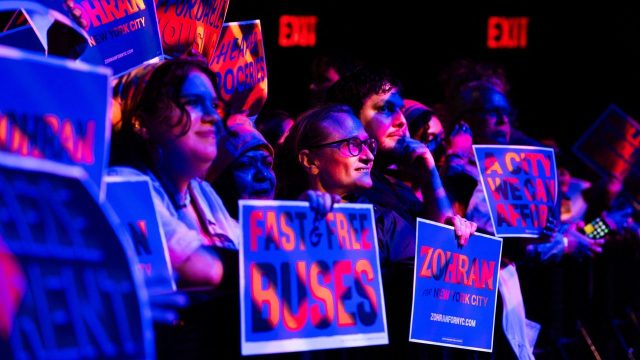
Zohran Mamdani, the democratic socialist candidate running for New York City mayor, has proposed free public buses as part of his campaign. It’s become a major part of his platform, as he and his supporters argue that free buses could increase ridership and efficiency, as well as benefit lower-income New Yorkers. But the suggestion also has its fair share of critics, who say it would greatly reduce bus safety, increase taxes and may not even be feasible.
Get on board
Implementing free New York City buses could “increase ridership citywide by 23%, an additional 170 million trips in a year and increase the average bus speed,” said The New York Times. Making buses faster also “incentivizes people to ride the bus who might otherwise now be taking an Uber” or a taxi, said economist Charles Komanoff to NPR. Along with free fares, “building more dedicated bus lanes and other service upgrades could improve speed and ridership numbers further,” added the Times.
The proposal could also improve efficiency. “Assaults on bus operators may decline because passengers are not swiping a card or handing over cash,” said Slate. The boarding process could also be faster without the extra time needed to pay the fare. While there will be a drop in revenue because of the lack of fares, the “city would benefit economically because of the time and money that riders would save,” said the Times.
Free buses are also “fiscally progressive, disproportionately benefiting the less wealthy,” said Slate. It “removes a major barrier to transit access for low-income individuals,” said economics Professor Amitrajeet A. Batabyal at the Rochester Beacon. Fare elimination improves access to “nonwork activities, such as shopping, health care visits and social interactions, which may improve overall quality of life.” As a result, policymakers “ought to focus on the ability of such actions to reduce financial strain, improve health and even decrease contacts with the criminal justice system.”
Missing the bus
“There is no such thing as a free bus,” said The Washington Post editorial board. Removing fares “would cost more than $500 million annually to the MTA (Metropolitan Transportation Authority) in lost fares to make all buses free to riders,” said Vital City. To replace this revenue, the “city would have to provide those funds annually to the MTA either through a reallocation of existing approved funding under the mayor’s control or, more likely, a budget modification approved by the City Council.” The funding will have to come from taxpayers. More specifically, the city’s bus system is “controlled by the state, meaning any changes would need buy-in” from Gov. Kathy Hochul (D), said the Post. She has “already ruled out raising taxes on high-income residents to pay” for Mamdani’s agenda.
Free buses can also lead to “major safety issues,” said Paul J. Gessing, the president of the Rio Grande Foundation, a New Mexico-based think tank, at the National Review. Especially in increasingly extreme weather, they might become “rolling homeless shelters.” If there is free unlimited bus access to buses, “vagrants and drug addicts would camp out all day,” said the Post. In turn, “parents would grow afraid to let their children ride alone.” While “wealthier residents would find another way to get around,” those who are poor and most dependent on the buses would “suffer the most.”
Mamdani’s free bus plan may be a lofty promise to begin with, as it would “require cooperation from state leaders and the MTA, which is state-run, and might require some concessions on his part,” said Al Jazeera. The MTA is also “under additional pressure from the federal government.” Mamdani “understands that transportation affects job prospects, influences public health, and helps shape the cost of living,” said Slate. “Many of his proposals are creative and worthwhile. Nixing bus fares is an exception.”
A transit innovation or a costly mistake






